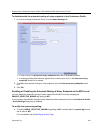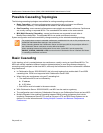
Polycom®, Inc. 239
Defining Cascading Conferences
Cascading enables administrators to connect one conference directly to one or several conferences,
depending on the topology, creating one large conference. The conferences can run on the same MCU or
different MCUs.
There are many reasons for cascading conferences, the most common are:
● Connecting two conferences on different MCUs at different sites.
● Utilizing the connection abilities of different MCUs, for example, different communication protocols,
such as, serial connections and ISDN, etc.
Conferences are Cascaded when a link is created between two conferences, usually running on two
different MCUs.
Cascading Link Properties
Cascade links are treated as endpoints in CP conferences. They are allocated resources as any other
endpoint according to Default Minimum Threshold Line Rates and Resource Usage Summary.
They transmit audio, video and content between conferences as well as DTMF codes input from other
endpoints in the conference.
Setting the Video Layout in Cascading conferences require additional consideration.
Setting the Video Layout in Cascading conferences (CP and mixed CP
and SVC)
When cascading two conferences, the video layout displayed in the cascaded conference is determined by
the selected layout in each of the two conferences. Each of the two conferences will inherit the video layout
of the other conference in one of their windows.
In order to avoid cluttering in the cascaded window, it is advised to select appropriate video layouts in each
conference before cascading them.
Cascading information applies to AVC Conferencing Mode (CP and mixed CP and SVC) only.
Cascading is not supported with SVC Conferencing Mode.


















